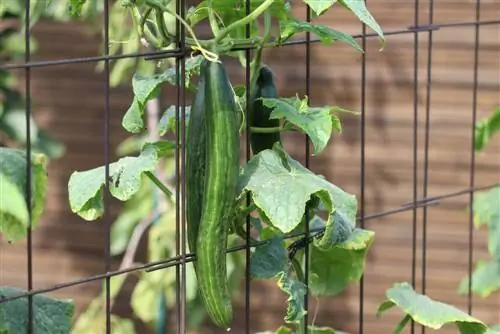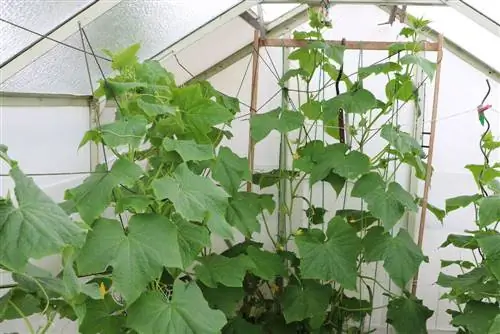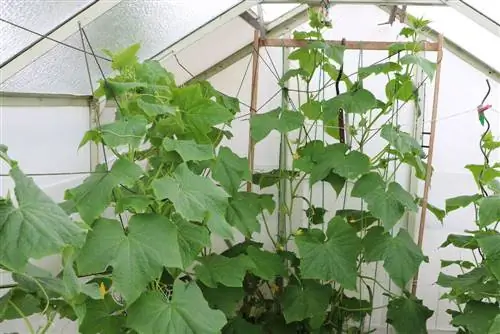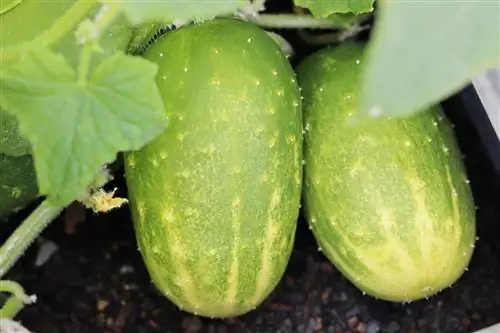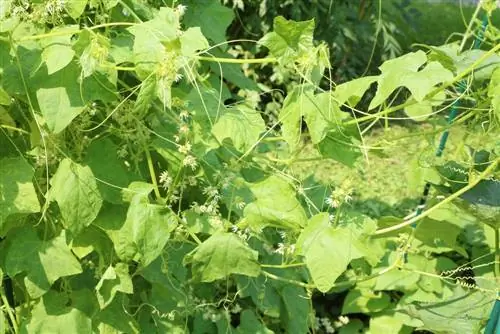- Author admin [email protected].
- Public 2023-12-17 03:39.
- Last modified 2025-01-24 12:45.
Whether cucumbers are grown in a greenhouse or outdoors, the plants are susceptible to diseases and are difficult to forgive care errors. Cucumber wilt is a particularly serious danger both for the affected cucumber itself and for other and subsequent plants. This is because the fungal infection is stubborn and can survive for a long time in the form of spores. The correct approach is therefore crucial.
Identifying cucumber wilt
At the beginning of cucumber wilting, the leaves appear wilted during the day. However, they recover at night. Therefore, it is difficult to recognize the disease at first. Obviously it will only do so when not only the leaves but also the shoots and stems wilt and no longer recover overnight.
As a result, individual shoots and finally the entire plant die. Other than the wilting leaves and progressive dieback, there are no other signs of the fungal infection. This also makes early detection more difficult, which means the disease can spread unnoticed to other plants.
Treatment
Unfortunately, cucumber wilt cannot be treated. To prevent further spread and reduce the risk of reinfection, the affected cucumber plant must be removed immediately. In addition, it must not be disposed of in the compost, but rather should be placed in the household waste, packaged as airtight as possible. This prevents the spores from spreading further into the environment. If the cucumber was cultivated in a greenhouse, it is best to carefully chop it up in the greenhouse and pack it in a bag. As a result, the plants in the vicinity of the infected plant should be closely observed and, if there are signs of cucumber wilt, they should also be removed and destroyed. It is also important to change the soil. The spores of the fungal infection can also be found in the substrate and cause renewed infections with cucumber wilt the following year.
Tip:
If you want to reuse the soil and not dispose of it completely, you can heat it in portions in the oven to 150 to 200 °C. This treatment kills the fungal spores.
Risk of cucumber wilt
The risk of cucumber wilt is increased when the plant is weakened. One of the most common reasons for this is care errors or unfavorable conditions at the location. These include:
- Draft
- cold watering water
- Waterlogging
- too dense substrate
- cold ground
- repeated culture at the same location
- location too dark
- blazing midday sun or lack of protection
Even strong temperature fluctuations can weaken the resistance of the cucumber and thus increase the risk of diseases - not just cucumber wilt. Corresponding prevention can be achieved by adjusting the culture of the cucumber accordingly. Although there is still no guaranteed protection against disease, the risk of this is significantly lower.
Prevention
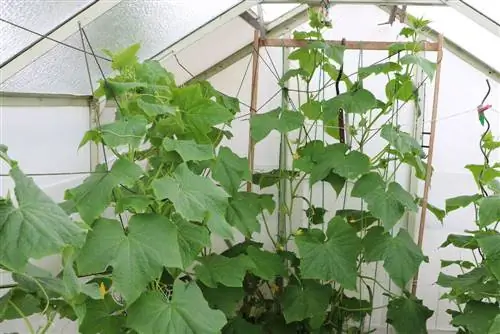
To prevent cucumber wilt or if it has already broken out, the culture conditions should be carefully considered. The following factors are important for resilience but also for strong growth and high yield.
Location
The planting site should be bright and protected. Drafts, huge temperature fluctuations and cold soil are unsuitable for the cucumber. However, blazing midday sun is also unfavorable. A slightly shaded location is ideal - for example behind a larger plant. Proximity to walls and walls can also provide protection. In the greenhouse, however, care should be taken to ensure adequate and timely ventilation when the weather changes.
Floor
Since the cucumber does not tolerate waterlogging, care should be taken to use a permeable substrate and secure water drainage. If the plant is grown in a pot, a drainage layer can be added to the bottom of the planter.
Sun protection
The cucumber can also get too much sun in otherwise protected locations. If shading cannot be secured at midday, shading nets can be used. These prevent heavy evaporation via the leaves, burns and drought damage. They also reduce the amount of water required and the effort involved in watering.
Pouring
The cucumber requires a relatively large amount of water and should be kept slightly moist as much as possible. When watering, you should also make sure that the water is not too cold. On the one hand, the cold water could lead to temperature fluctuations and thereby weaken the plant. On the other hand, this can make the cucumbers taste bitter. It therefore makes sense to choose not to take the water from the tap too cold or to let it sit for a few hours before watering the cucumbers. This allows it to approach room temperature so that there are no abrupt temperature fluctuations during watering.
Temperature fluctuations
Over 30°C during the day, around ten degrees Celsius at night - such temperature fluctuations are not uncommon in summer, but they are hard on the cucumber plant. A protected location can somewhat absorb extreme differences. The greenhouse should be ventilated early before any upcoming weather changes. In greenhouses and outdoors, protection can be used to absorb temperature fluctuations by spreading foil and applying bark mulch to the soil.
Change location
Since cucumbers are very susceptible to diseases, over time an increasing number of germs, such as cucumber wilt spores, can be found in their environment and the substrate. For this reason, the location of the cucumber plant should be changed every year. It is advisable to take a break of three to four years before cultivating the cucumber in the same location again.
Resistant varieties
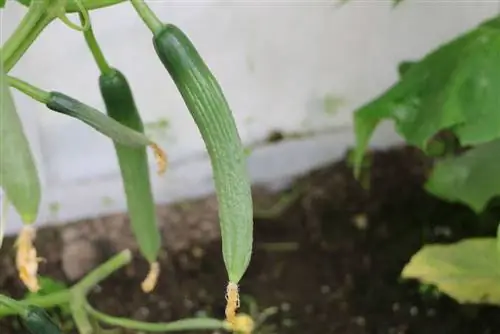
Another preventative measure against cucumber wilt and other diseases is to choose resistant varieties. Any cucumber plant that has been grafted onto a pumpkin base is a sensible choice. A cucumber shoot is fixed on a rooted pumpkin shoot so that the interfaces can grow together. This measure makes the cucumber plant resistant to fungal diseases and bacterial infections, among other things. However, care must be taken to ensure that the processing point is always above ground level. If it is kept too moist or has direct contact with the substrate, the interface of the cucumber plant stem could also develop roots again. The resistance of the pumpkin base is no longer necessary. In addition, rot and competing shoots can form.
Tip:
The grafting site can be recognized by a thickening and a kind of scar at the lower end of the plant stem. However, with time and growth, this area becomes less noticeable. A loose ribbon or colored marking can help prevent soil from piling up over the area and also keep it wet from watering.

